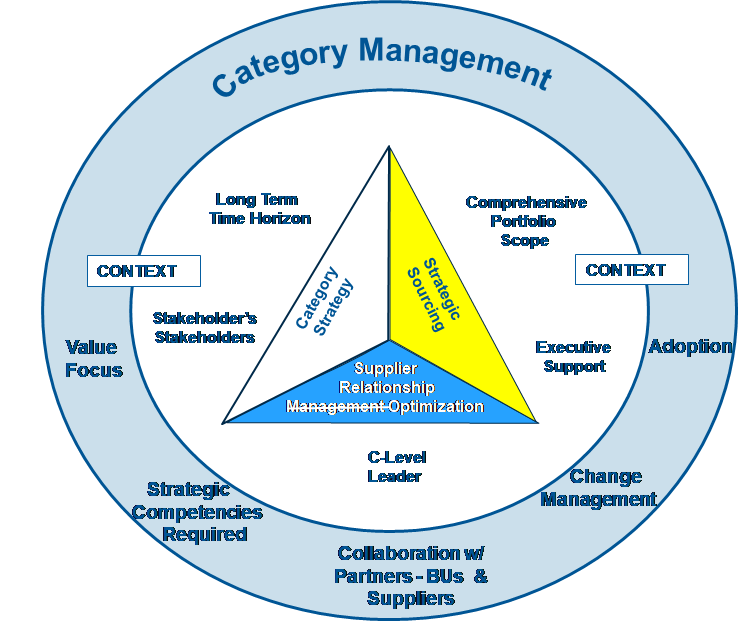For those of you that have been loyal followers of this blog for the last few years as we have explored the differences between Strategic Sourcing and Category Management, you will recall seeing this model many, many times:

You will also recall many, many discussions around strategic competencies which you will see in the outer circle of our model. Why so much emphasis on competency? That’s easy – Category Management MUST be executed by people, on behalf of people and with the cooperation of people (not BOTS, AI or some other new emerging technology) so the people (Category Managers) that execute that process MUST be armed with the skills, competencies and behaviors that can bring about that change. Category Management emerged from Strategic Sourcing which was started in the consulting world (which continues to have $$$$million practice areas supporting it). If you have worked with external consultants you will recognize some common qualities / strategic competencies (I will mention only a few) – they are well-armed with a “consulting” process, they are great communicators, they know how to lead change and their primary job is to persuade you to implement their recommendations. So, it only makes sense that if you are building an organization to do Strategic Sourcing and eventually Category Management on your own, you must have resources with the same qualities (competencies) as external consultants.
Now let’s focus on those competencies. Please note, I did NOT mention processing POs, writing RFPs, developing negotiation strategies because without the strategic competencies mentioned above those functional skills are worthless because if I can’t persuade my business unit partners and suppliers to work with me then the best RFPs in the world won’t help. I mentioned the “consulting” process above – here are the primary elements:

There is both a science (a disciplined four step process that is taught to every consultant in their initial boot camp) and an art to this process, particularly in the persuade step. Please note that persuade is pictured at the end of the process but to be effective a consultant must be taking their client with them on their journey; in other words, persuading along the way. By the way this is not a new process or even one that the big consulting firms recently developed. The “art” of persuasion was introduced over 2,000 years ago by none other than Aristotle ! An article in HBR “The Art of Persuasion Hasn’t Changed in 2,000 Years” notes, “Ideas are the currency of the twenty-first century. The ability to persuade, to change hearts and minds, is perhaps the single greatest skill that will give you a competitive edge in the knowledge economy — an age where ideas matter more than ever. In short, persuasion is no longer a “soft skill”— it is a fundamental skill that can help you attract investors, sell products, build brands, inspire teams, and trigger movements.”
Aristotle offered five rhetorical devices to consider:
- Ethos – demonstrate your character. You must build a sense of trust between you and your client. The people you are working with must believe that you can be trusted and will do what you say you will do.
- Logos – make a logical appeal. The other steps of the consulting process (planning, data gathering and analysis) provide you with the data and facts to support your argument.
- Pathos – “persuasion cannot occur in the absence of emotion”. Wrap your idea in a story. The art of storytelling is a very powerful tool in persuasion. Consultants often use other client case studies or personal experiences to bring their argument to life.
- Metaphor – paint a picture for your client in words. For those of you that have been through our change management training we use a megaphone to illustrate that the sooner you start change management (the lower end of the megaphone) the less pain and disruption you will need to deal with. The longer you wait (the wide end of the megaphone) the more issues and challenges you will need to deal with.
- Brevity – keep your message short, succinct and tailored to your audience. Consultants aren’t necessarily known for their brevity. Don’t we all wish they were?
According to the article, “the good news for communicators is that Aristotle believed that persuasion can be learned. In fact, . . . he was viewed as “quite threatening” to the political class in ancient Greece when he made the tools of rhetoric available to the masses. He championed the idea that a person’s ability to speak and write well, and to use rhetorical devices to change another’s perspective, could unleash human potential and maximize happiness.”
As you are thinking about building the required skills and competencies for your organization to move to Category Management, give us a call. We have a great consulting skills bootcamp that combines both the art and science of persuasion which is a necessary element in your journey.
Let us know what you think and join in the conversation . . . . .

